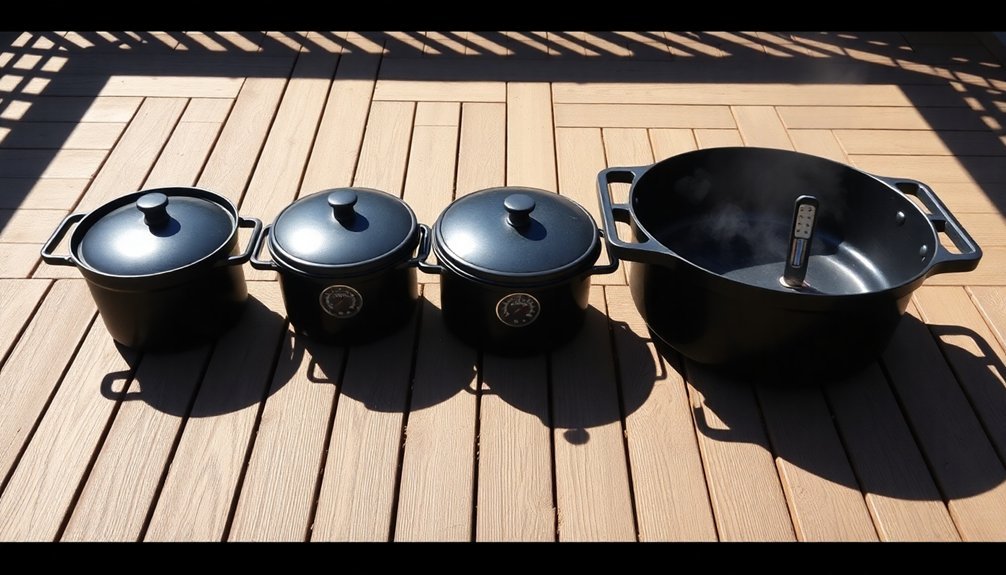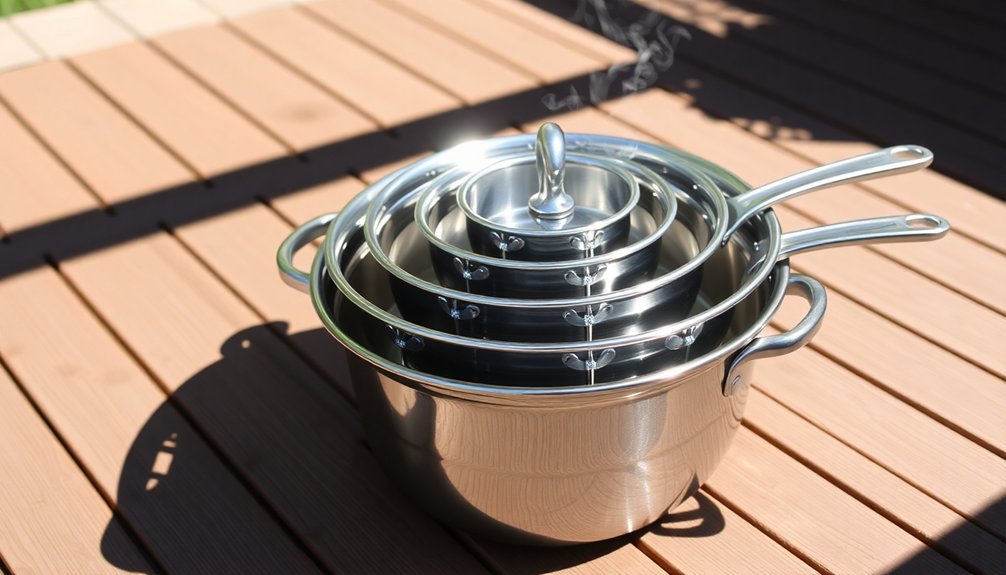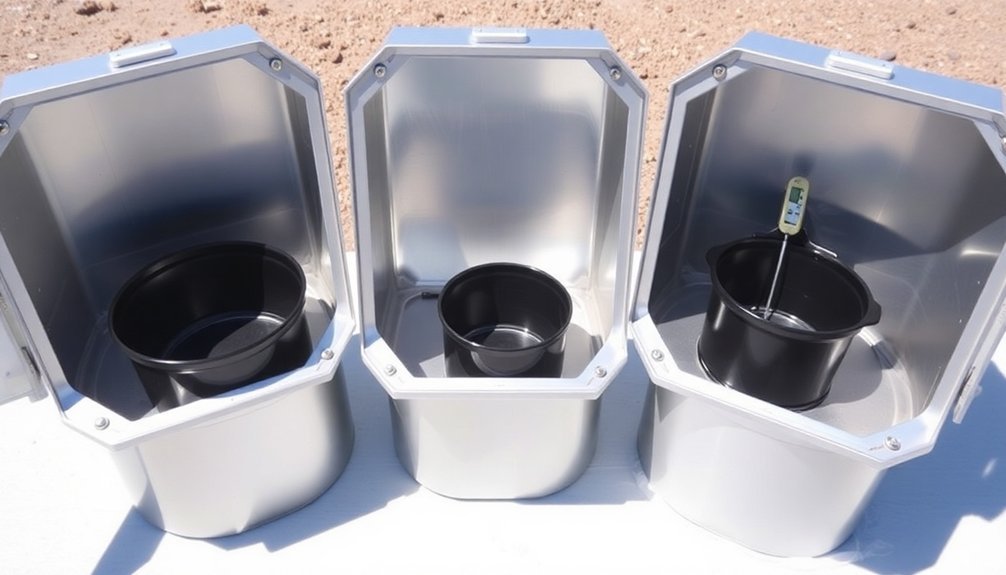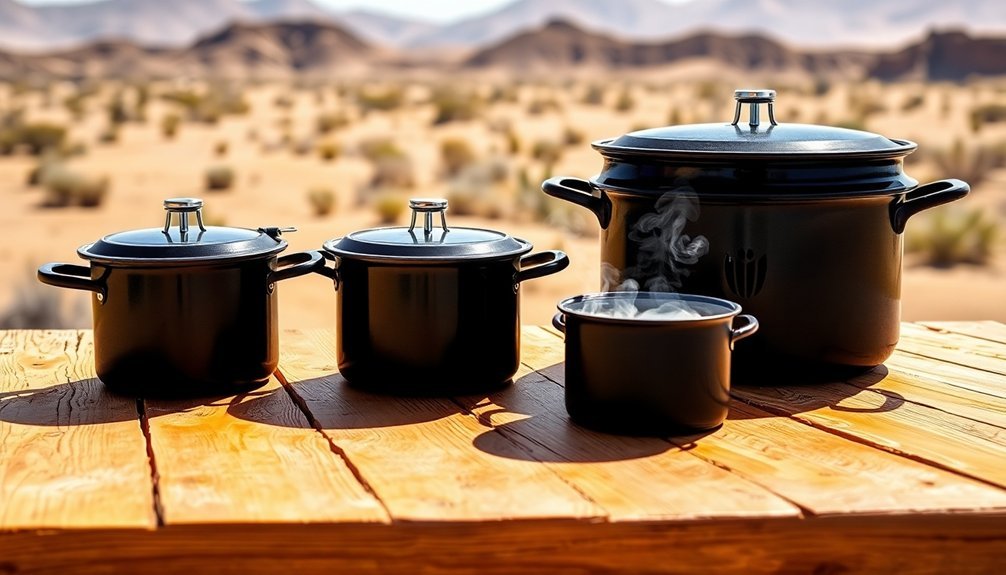For ideal sun cooking, you'll want a dark-colored container around 5 quarts in capacity, with dimensions roughly 14 x 14 inches and 8 inches deep. This size works well in most standard solar ovens while providing enough space for family meals. A black enamel turkey roaster or covered casserole dish fits these specifications perfectly. Shallow containers heat faster but limit your cooking options, while deeper vessels allow for versatile meal preparation like stews and soups. Using containers with tight-fitting lids will help trap heat effectively. Understanding the relationship between container size and cooking efficiency can transform your solar cooking experience.
Standard Solar Oven Container Sizes

When choosing a container for your solar oven, you'll need to contemplate the standard dimensions that most commercial models accommodate. Popular units like the Global Sun Oven and All American Sun Oven feature interior dimensions of 14 x 14 inches, tapering to 8 inches in depth at the front.
You can maximize your cooking space with a mid-size black enamel turkey roaster, which offers excellent capacity. A 5-quart covered casserole dish also fits perfectly inside these standard models. With proper insulation materials, these containers can maintain high temperature retention for extended cooking periods.
If you prefer using round pots, you'll be pleased to know you can double-stack them on the leveling tray. While the 9-inch round roaster fits well, it might be too small for larger meals.
For most cooking needs, you'll find that both round and square pots work effectively in these standard solar ovens.
Depth and Width Guidelines
When choosing between shallow and deep pots for your solar cooker, you'll find that shallow containers heat up faster but limit your cooking options, while deeper vessels allow for more versatile meal preparation.
The width of your container plays an essential role in heat distribution and stability, with wider pots typically providing more consistent cooking temperatures across the food surface. It's important to select nontoxic containers that won't leach harmful substances into your food when heated.
For ideal performance in most solar ovens, you'll want to maintain a height-to-width ratio of roughly 1:2, ensuring efficient heat absorption while maximizing the cooking area.
Shallow Vs Deep Pots
Two key factors determine the effectiveness of your sun cooking container: depth and width.
When choosing between shallow and deep pots, you'll need to evaluate your cooking method and desired results. The shape affects heat distribution throughout your cooking process.
Deep pots excel at moisture retention, making them ideal for stews, soups, and dishes that require sustained heat and pressure.
They'll keep your food submerged and maintain consistent cooking conditions, perfect for larger quantities and liquid-based meals.
Shallow pots, however, offer faster cooking times due to better heat circulation.
You'll find them more suitable for quick-cooking methods like sautéing and pan-grilling.
Their wide base and low sides allow moisture to escape, creating drier results.
They're especially effective for foods with natural water content and dishes that don't require high moisture retention, like vegetables and flatbreads.
Container Width Considerations
Selecting the right container width for your solar cooker dramatically affects its performance and efficiency. You'll want to choose containers that align with your cooker's east-west orientation to maximize solar collection throughout the day.
The width of your container should work with, not against, your cooker's design. For best results, use containers that allow sufficient space between the pot's sides and the cooker's walls for proper insulation.
If you're using a box-style cooker, verify there's enough airspace between the inner and outer boxes. Your container shouldn't be so wide that it compromises the insulation layer, as this could reduce cooking temperatures.
Optimal Height-to-Width Ratios
Proper height-to-width ratios are critical for maximizing your solar cooker's performance. You'll want your inner box to extend just 2.5 cm above your cooking pot, while maintaining a 2.5-5.0 cm height difference between your inner and outer boxes. This creates an effective insulation layer that traps heat and guarantees even cooking.
- Keep a consistent 1.5-5 cm airspace between your inner and outer boxes on all sides.
- Position your pot on a 6 cm high wire stand to allow sunlight reflection underneath.
- Make sure your inner box fits snugly around the pot to minimize heat loss.
- Select an outer box that's tall enough to capture and reflect additional sunlight onto your inner container.
These proportions will help you achieve ideal heat retention and cooking efficiency in your solar cooker.
Dark Container Benefits

Dark containers offer you significant advantages when sun cooking, as their surfaces absorb maximum sunlight and convert it into usable heat energy.
You'll notice faster temperature increases with dark-colored cookware since it efficiently captures and transfers solar energy into your food.
Your cooking times will improve because dark containers help maintain consistent temperatures throughout the cooking process, making the most of available sunlight.
Maximum Heat Absorption
The most essential aspect of solar cooking container design centers on maximizing heat absorption.
You'll want to choose dark-colored containers, especially matte black ones, as they're highly efficient at converting sunlight into heat energy. A glass or clear plastic lid helps trap the absorbed heat while allowing sunlight to penetrate, creating an effective cooking environment.
- Position your container to capture maximum sunlight exposure, typically between 200-300°F for ideal cooking.
- Select materials that efficiently absorb heat, avoiding bright or reflective surfaces.
- Use insulation around your container to retain the captured heat.
- Consider adding reflective surfaces around the setup to concentrate more sunlight onto your dark container.
Remember to monitor the internal temperature and include proper safety measures to protect yourself from reflected light while cooking.
Quick Temperature Rise
Selecting containers with dark surfaces dramatically accelerates your solar cooker's heating process. Your dark containers will absorb sunlight efficiently, converting it directly into heat energy that radiates throughout the cooking chamber.
You'll notice faster temperature increases because dark surfaces minimize sunlight reflection, ensuring more energy stays within your cooker.
For best results, you'll want to use dark metal containers that combine excellent heat absorption with high thermal mass. These materials not only capture heat effectively but also distribute it evenly throughout your food.
When you pair dark containers with reflective panels and proper insulation, you'll create an efficient cooking environment that reaches higher temperatures more quickly.
Efficient Energy Transfer
Building on your quick temperature rise strategy, maximizing energy transfer becomes your next key focus.
You'll want to choose dark-colored containers made from materials like glass, ceramic, or metal to absorb sunlight effectively. Black containers work best, as they convert light energy into heat through enhanced conduction, creating a greenhouse effect inside your solar cooker.
- Use a dark container that fits snugly inside your cooker to maximize heat transfer.
- Add insulation between the outer and inner boxes using newspaper or similar materials.
- Install reflector panels made of mirrored aluminum to direct more sunlight onto your cooking vessel.
- Confirm your container has a proper seal to prevent moisture condensation on the glass cover.
The combination of these elements will greatly boost your solar cooker's efficiency and reduce cooking times.
Material Selection for Solar Cooking
Successful solar cooking depends heavily on choosing the right materials for three critical components: structure, insulation, and glazing.
You'll need durable structural materials like wood, metal, or bamboo to provide stable form, while insulating materials such as feathers, rockwool, or fiberglass prevent heat loss around your cooking chamber.
For the glazing, you'll want either glass or plastic to create a transparent surface that lets sunlight in while trapping heat.
Double glazing can cut heat loss by half, though it may slightly reduce solar transmission.
Don't forget about moisture protection – you'll need a good vapor barrier on the innermost surface to protect your insulation and structure from water damage.
Materials like plastic or treated wood work well for this purpose, preventing moisture from seeping into the box walls.
Multiple Container Stacking Techniques

To maximize your solar cooker's efficiency, proper container stacking creates essential insulation layers and heat retention zones.
You'll need two cardboard boxes – the inner box should sit one inch lower than the outer box's rim, following a 1:2:3 ratio for height, length, and width. When assembling the layers, bend the inner box's top flaps outward to fit snugly between both containers.
- Stack corrugated cardboard layers at the bottom of the outer box, using doubled-over pieces for enhanced insulation.
- Fill gaps between boxes with rigid foam, fiberglass, or crumpled newspaper.
- Line the cooking area with black construction paper and secure the inner box's rim tightly.
- Create an insulated seal by wedging the materials firmly between both containers, ensuring no heat escapes through gaps.
Heat Retention and Capacity
When designing your solar cooker's container system, proper heat retention and capacity management directly impact cooking performance. You'll need containers with dark-colored, thin walls made of heat-conducting materials like glass or metal. Make sure they're fitted with tight lids to trap heat effectively.
| Heat Retention Features | Capacity Benefits |
|---|---|
| R3+ window insulation | 5 qt volume ideal |
| R50-90 side insulation | Multiple dishes |
| Cork/sand protection | Stackable design |
| Sealed construction | Variable heights |
| Reflective surfaces | Compact storage |
Your container shouldn't leave excessive space in the cooker, as this reduces efficiency. Best dimensions include heights between 13-23 cm and widths around 30 cm. Consider rectangular shapes that maximize space usage and allow for cooking multiple dishes simultaneously. Remember, smaller containers heat up faster, but larger ones offer more cooking flexibility.
Matching Containers to Oven Types

Selecting appropriate containers for your solar oven depends heavily on the specific type and dimensions of your cooker.
You'll find that commercial models like the Global Sun Oven work well with 5-quart casseroles and black enamel turkey roasters, while the SunTaste 200 XL can fit both rectangular dishes and taller pans simultaneously.
- Choose dark-colored containers that'll absorb sunlight effectively – black enamel or thin-walled metal pots are ideal.
- Verify your container is smaller than your oven's interior dimensions, allowing easy placement and removal.
- Use containers with lids to retain heat, but don't cover them with aluminum foil as it reflects sunlight.
- Consider shallow containers for faster cooking times, and remember you can double-stack smaller pots in larger ovens.
Optimal Container Shape Factors
While solar cooking success depends on multiple factors, the shape of your container plays an essential role in heat absorption and distribution.
You'll want to choose containers with flat bottoms that fit snugly in your solar oven to maximize heat efficiency. The container's height shouldn't be too deep, as this helps distribute heat more evenly throughout your food.
For best performance, select dark-colored containers made of heat-conducting materials like glass or metal. These materials absorb and retain heat better than lighter alternatives.
If you're using a funnel cooker, match your container's diameter to the funnel's circumference. Don't forget to verify your container has proper ventilation to release steam and prevent pressure buildup.
A transparent lid can be helpful for monitoring your food without opening the oven and losing precious heat.
Container Capacity Planning

The right container size can make or break your solar cooking success. When planning your container capacity, you'll need to balance cooking needs with heating efficiency.
Small containers like pizza boxes heat up quickly and work well for simple meals, while larger containers can handle family-sized portions but require more time and insulation.
- Choose small containers for quick-cooking items like eggs, melted cheese, or vegetables – they're also perfect for camping trips.
- Select medium to large containers when cooking for families or when you need thermal mass for heat retention.
- Consider modular designs that let you adapt to different meal sizes and cooking requirements.
- Factor in your available materials and budget – larger containers need more insulation and reflective surfaces.
Frequently Asked Questions
Can Plastic Containers Be Safely Used in Solar Ovens?
You shouldn't use plastic containers in solar ovens as they can leach harmful chemicals into your food. Instead, opt for food-grade glass, metal, or aluminum containers that'll safely withstand high temperatures while cooking.
How Does Altitude Affect Container Size Selection for Solar Cooking?
At higher altitudes, you'll need slightly larger containers since cooking times increase. Choose containers that are 20-30% bigger than you'd use at sea level to compensate for reduced atmospheric pressure.
Should Container Sizes Change When Cooking in Different Seasonal Conditions?
You'll want to adjust container sizes seasonally. In colder weather, use larger containers to retain heat better. During cloudy conditions, heavier pots maintain temperature well. Multiple smaller containers work great for distributing heat evenly.
Do Magnetic Metals Affect Solar Oven Performance Compared to Non-Magnetic Containers?
No, magnetic metals won't considerably affect your solar oven's performance. Your container's color, surface finish, and insulation matter more than magnetic properties. Focus on dark surfaces and proper insulation for best cooking results.
Can Containers With Copper Bottoms Be Used Effectively in Solar Ovens?
You can use copper-bottomed containers in solar ovens, but they'll work best if darkened since copper is naturally reflective. While copper conducts heat well, dark aluminum pots are typically more practical and cost-effective.
In Summary
You'll find the most success with dark-colored containers that are 2-4 inches deep and 8-12 inches wide. For best solar cooking results, choose containers that match your solar oven's dimensions while leaving space for heat circulation. Stack smaller containers when possible, but don't overcrowd. Remember, your container material matters – opt for thin-walled metal or ceramic vessels that absorb and retain heat efficiently.





Leave a Reply